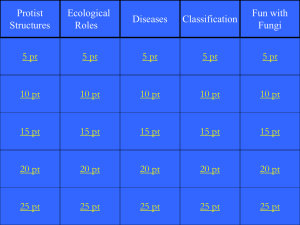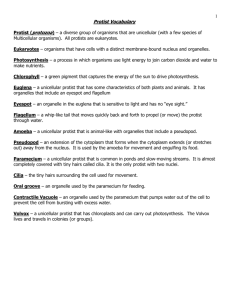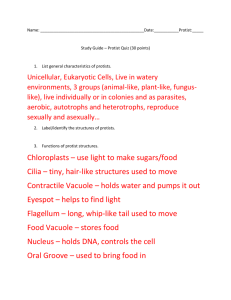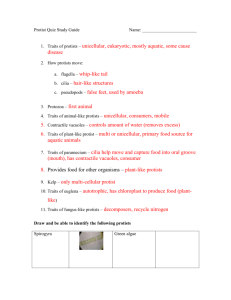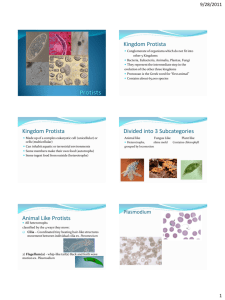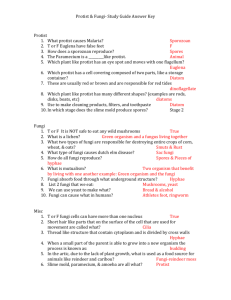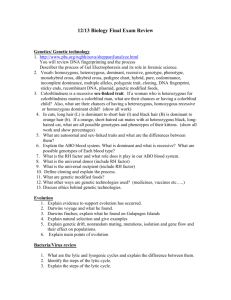Nitrogen-Sparged l\iedia Extends Life Span of Symbiotic Protists
advertisement
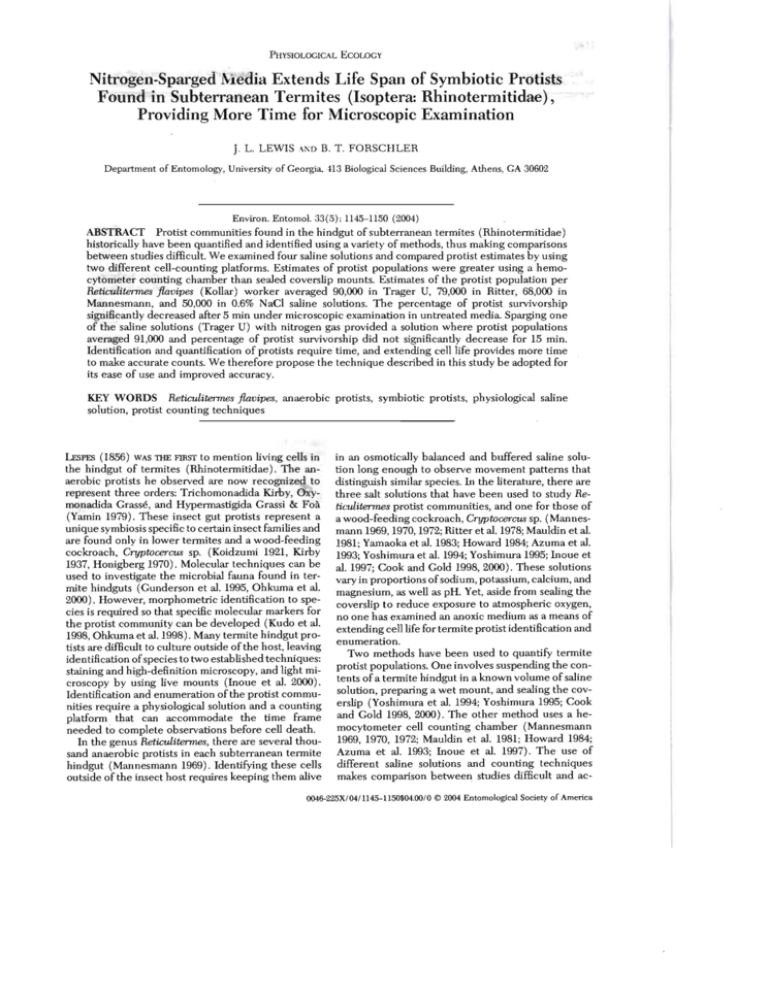
PHYSIOLOGICAL ECOLOGY
Nitrogen-Sparged l\iedia Extends Life Span of Symbiotic Protists
Found in Subterranean Termites (Isoptera: Rhinotermitidae),
Providing More Time for Microscopic Examination
J.
L. LEWIS
A1"D
B. T. FORSCHLER
Department of Entomology, University of Georgia. 113 Biological Sciences Building, Athens, GA 30602
Environ. Entomol. 33(5): 1145-1150 (2004)
ABSTRACT Protist communities found in the hindgut of subterranean termites (Rhinotermitidae)
historically have been quantified and identified using a variety of methods, thus making comparisons
between studies difficult We examined four saline solutions and compared protist estimates by using
two different cell-counting platforms. Estimates of protist populations were greater using a hemo­
cytometer counting chamber than sealed coverslip mounts. Estimates of the protist population per
Reticulitermes jlavipes (Kollar) worker averaged 90,000 in Trager U, 79,000 in Ritter, 68,000 in
Mannesmann, and 50,000 in 0.6% NaCI saline solutions. The percentage of protist survivorship
significantly decreased after 5 min under microscopic examination in untreated media. Sparging one
of the saline solutions (Trager U) with nitrogen gas provided a solution where protist populations
averaged 91,000 and percentage of protist survivorship did not significantly decrease for 15 min.
Identification and quantification of protists require time, and extending cell life provides more time
to make accurate counts. We therefore propose the technique described in this study be adopted for
its ease of use and improved accuracy.
KEY WORDS Reticulitermes jlavipes, anaerobic protists, symbiotic protists, physiological saline
solution, protist counting techniques
(1856) WAS TIIE FIRST to mention living cells in
the hindgut of termites (Rhinotermitidae). The an­
aerobic protists he observed are now recognized to
represent three orders: Trichomonadida Kirby, Oxy­
monadida Grasse, and Hypermastigida Grassi & Foa
(Yamin 1979). These insect gut protists represent a
unique symbiosis specific to certain insect families and
are found only in lower termites and a wood-feeding
cockroach, Cryptocercus sp. (Koidzumi 1921, Kirby
1937, Honigberg 1970). Molecular techniques can be
used to investigate the microbial fauna found in ter­
mite hindguts (Gunderson et al. 1995, Ohkuma et al.
2000). However, morphometric identification to spe­
cies is required so that specific molecular markers for
the protist community can be developed (Kudo et al.
1998, Ohkuma et al.1998). Many termite hindgut pro­
tists are difficult to culture outside of the host, leaving
identification ofspecies to two established techniques:
staining and high-definition microscopy, and light mi­
croscopy by using live mounts (Inoue et al. 2000).
Identification and enumeration of the protist commu­
nities require a physiological solution and a counting
platform that can accommodate the time frame
needed to complete observations before cell death.
In the genus Reticulitermes, there are several thou­
sand anaerobic protists in each subterranean termite
hindgut (Mannesmann 1969). Identifying these cells
outside of the insect host requires keeping them alive
LEsPES
in an osmotically balanced and buffered saline solu­
tion long enough to observe movement patterns that
distinguish similar species. In the literature, there are
three salt solutions that have been used to study Re­
ticulitermes protist communities, and one for those of
a wood-feeding cockroach, Cryptocer:cus sp. (Mannes­
mann 1969, 1970, 1972; Ritler et al. 1978; Mauldin et al.
1981; Yamaoka et al. 1983; Howard 1984; Azuma et al.
1993; Yoshimura et al. 1994; Yoshimura 1995; Inoue et
al. 1997; Cook and Gold 1998,2000). These solutions
vary in proportions ofsodium, potassium, calcium, and
magnesium, as well as pH. Yet, aside from sealing the
coverslip to reduce exposure to atmospheric oxygen,
no one has examined an anoxic medium as a means of
extending cell life for termite protist identification and
enumeration.
Two methods have been used to quantify termite
protist populations. One involves suspending the con­
tents of a termite hindgut in a known volume of saline
solution, preparing a wet mount, and sealing the cov­
erslip (Yoshimura et al. 1994; Yoshimura 1995; Cook
and Gold 1998,2000). The other method uses a he­
mocytometer cell counting chamber (Mannesmann
1969, 1970, 1972; Mauldin et al. 1981; Howard 1984;
Azuma et al. 1993; Inoue et al. 1997). The use of
different saline solutions and counting techniques
makes comparison between studies difficult and ac-
0046-225X/04/1145-115O$04.OO/0 © 2004 Entomological Society of America
1146
Vol. 33, no..5
ENVIRONMENTAL ENTOMOLOGY
Table I. Composilion oJ physiological saline ...Iulion. used for studies of .ublerranean Iennile protisl1l in grams of sail ingredienl per
50 ml of distilled waler
ingredient
NaCI
KCt
CaCL,
NaHC03
NaHzPO. H,O
KH 2PO.
MgSO. iH,O
Na3CJ'1s072H20
KHC03
Trager U (g)
(1934)
Ritter (g)
(1959)
Mannesmann (g)
(J969)
0.60% NaCI (g)
(Kirby 1932)
pH i.1
pH 7.1
pH i.8
pH 7.0
0.300
O.l24i
0.041
00400
0.010
0.010
0.005
0.1082
0.0041
0.0386
0.0145
0.0892
0.0024
O.Oi54
0.03i6
0.0333
counting for the variation reported in the literature
impossible.
In this article, we compared protist estimates from
the hindgut of Reticulitermesfiavipes (Kollar) by using
a hemocytometer with those from a sealed wet mount
We also describe experiments using hemocytometer
protist estimates to compare different physiological
saline solutions. Our objective was to review and con­
solidate the literature and to determine whether any
of the previously described saline solutions affect pro­
tist sUlvivorship over time. In light of our findings, we
propose a standardized technique that is time effi­
cient, simple, and accurate. We hope these studies
stimulate discussion on standardization of methods
used to quantify termite protists, which will be im­
portant in gaining a better understanding of this im­
portant symbiosis.
Materials and Methods
Insects. One pine (Pinus sp.) log infested with R.
fiavipes was collected from Whitehall Forest in Ath­
ens, GA, and returned intact to the laboratory. The
termites were identified to species by using published
keys to the soldier caste (Scheffrahn and Su 1994) and
extracted from the log as described by Forschler and
Townsend (1996). Once collected, termites were kept
in plastic boxes (26.99 by 19.37 by 9.52 cm) with pine
slats (=12.5 by 2.54 by 0.2 cm) and placed inside an
environmental chamber where they were maintained
in complete darkness at 24°C. Voucher specimens
were preserved in 100% ethanol and deposited at the
University of Georgia Museum of Natural History.
Preparation of Sample Unit for All Protist Counts.
Protist population estimates were obtained by count­
ing all living cells from individual tennites collected
from a single tennite colony. The contents of one
termite alimentary tract were placed in 80 ,...1 of a
selected saline solution. This constituted one replicate
in all of these experiments. Protists were determined
to be alive if the flagella and/ or axosyle were moving
and the cell membrane was intact Dead cells were
defined as those that exhibited no movement in any of
the aforementioned structures. Solutions (Table 1)
were prepared on a weight-to-weight basis in a 2oo-ml
glass sample bottle (Wheaton Science Products,
Millville, NJ), sterilized in a steam autoclave for 20 min
at 130°C and pipetted from that reservoir by using
disposable tips.
Only fourth instar or older worker termites with
dark brown abdomens were selected for protist counts
to ensure they had not recently molted. The last two
abdominal segments were removed from a termite
with forceps, thus extracting the alimentary canal that
was then placed in a microcentrifuge tube containing
the appropriate saline solution. The alimentary tract
was gently homogenized in the microcentrifuge tube
for 10 s by using a disposable pestle. We also examined
the technique of gently squeezing the hindgut con­
tents into the saline solution, but found it had no affect
on protist estimates (F = 0.0032, df = 8, P = 0.9559)
compared with the homogeniZing technique. We
therefore chose to conduct these experiments by us­
ing the homogenizing technique because it was effi­
cient and time-effective (unpublished data). All pro­
tists were counted at 40QX magnification using a
Nikon compound microscope.
The numbers of protists per individual termite were
detennined using the following formula: (number of
protists counted X volume of saline solution in the
original suspension) /volume of saline solution from
which protists were counted. Percent protist survi­
vorship was calculated by taking cell counts in 5-min
increments.
Comparing Protist Counting Platforms. We com­
pared protist population estimates by using a wet
mount, with those using a hemocytometer cell count­
ing chamber. All counts were taken from a single
termite alimentary canal suspended in 80 ,...1 ofTrager
U saline as described previously and replicated three
times per counting platform. Wet mounts were pre­
pared by placing a 4-,...1 aliquot, from the aforemen­
tioned suspension, onto a glass slide and sealing the
coverslip with petroleum jelly. All cells were counted
according to the wet mount technique described in
Cook and Gold (1998). For protist estimates using a
hemocytometer, 10 ,...1 was loaded into a hemacytom­
eter (Neubauer, Brightline, Horsham, PA), and counts
were made from five small squares (0.0125 mm 2 equiv­
alent to 0.02 ,...1).
Saline Solution Comparison. Total protist popula­
tions were estimated from workers belonging to one R.
fiavipes colony and were compared using four differ­
ent saline solutions. Each replicate consisted of the
October 2004
1147
LEwIs AND FORSCHLER: MEDIA FOR COUNTING TERMITE PROTISTS
Table 2. Mean (±SD) estimates of Iotal protist populations per termite during microscopic examination in a hemoq'lometer by using
the time 0 COWlts as the starting point in 5 min increments for four physiological saline solutions
Min
o
5
10
15
20
25
30
35
40
Mean protist population estimate by physiological saline solution"
Trager U
90,400 :t
64,000 :t
55,200 :t
45,600 :t
33,600 :t
24,800:t
14,400 :t
10,400 :t
0.00 :t
13,446aA
16,000abA
14,805abcA
13,145bcA
11,865cdA
12,I33dA
9,20geA
7,266eA
O,OfA
Ritter
Mannesmann
79,200 :t 14,255aAB
64,000 :t 1O,I98abA
51,200 :t 12,l3.3bcAB
48,000 :t 9,381 bcA
41,600 :t 10,44OcA
27,200 :t 9,960dA
16,000 :t 2,82&A
8,800 :t 4,382fA
0.00 :t O.OgA
68,000 :t
48,800 :t
35,200:t
29,600 :t
24,800 :t
15,200 :t
8,000 :t
1,600 :t
0.00 :t
1O,198aB
4,382abB
10,733abBC
6,066abB
7,I55abA
7,694abA
5,657bA
2,191cB
O.odA
0.60% NaCI
50,400 :t
32,000 :t
24,000 :t
17,600 :t
8,800 :t
4,000 :t
1,600 :t
0,00 :t
0.00 :t
6,066aC
6,325aC
4,899aC
3,578aC
8,672bB
4,899bcB
3,578cdB
O,OdC
O,OdA
• Means :t SD within columns with the same lowercase leller, and within rows with the sanle uppercase leiter, were not significantly different
using Duncan's multiple range test (P < 0.05).
contents of a single termite gut suspended in 80 IlJ of
the appropriate solution and was counted using a he­
mocytometer. The solutions tested were 0.60% NaCI
(Kirby 1932, Trager (1934), Mannesmann 1969, Ritter
et al. (1978). Five replicates per saline solution were
performed.
In our experiments, protist samples were prepared
and initial cell counts made within 3 min of sample
preparation (time 0). Thereafter, protist counts were
taken every 5 min for 40 min from the same hemocy­
tometer mount. The four saline solutions were com­
pared using total protist population estimates and per­
centage of protist survivorship over time.
Anoxic Saline Solution. One saline solution was
examined to test the utility of sparging the solution of
oxygen. Trager U was used in these experiments be­
cause it is the most often cited saline solution (Azuma
et al. 1993; Yoshimura et al. 1994; Yoshimura 1995;
Inoue et al. 1997; Cook and Gold 1998, 2(00), has a
stable pH, and does not precipitate out of solution
when sterilized. One termite gut was homogenized, as
described previously, in 80 ILl of the appropriate so­
lution (standard or anoxic), and counts were made on
a hemocytometer every 5 min for 30 min, replicated
five times. All termites were worker nestmates as in
the other experiments. The anoxic solution was pre­
pared by bubbling a nitrogen gas mixture (92.5% N,
5.0% CO2, and 2.5% H) at 1 liter/min for 5 min into 6
ml of standard Trager U. For the sake of discussion, the
nitrogen-sparged solutions will be termed anoxic so­
lutions. Data used for analysis were total protist pop­
ulation estimates and percentage of protist survivor­
ship from anoxic and oxic solutions compared over
time.
Statistical Analysis. Data were transformed and an­
alyzed by one-way analysis of variance (ANOVA)
with means separated by Duncan's multiple range test
(P < 0.05) by using the Statisticafor Windows package
(StatSoft Inc., Tulsa, OK). The response variables
were transformed by taking the base-lO logarithm of
the total protist population and arcsine of the per­
centage of protist survivorship (Steel and Torrie
1960), but the data shown are untransformed for in­
terpretation.
Results
Comparing Protist Counting Platforms. Protist
population estimates of 86,667 ± 19,731 (SD) per
termite were obtained using the hemocytometer,
which was significantly greater than the estimate of
45,875 ± 4,904 protists obtained using the wet mount
technique (F = 16.057, df = 4, P = 0.0160).
Saline Solution Comparison. Protist population es­
timates were significantly greater with the Trager U
and Ritter's saline solutions overtime (F= 12.306, df =
178, P = 0.0006; Table 2). The data also were analyzed
using percentage of protist survivorship because of
variation in the time 0 counts between saline solutions
(Table 2). Protist survivorship decreased rapidly with
72.17 ± 12.52% of the protists counted in the first
survey still present after 5 min, in all saline solutions
combined (Table 3). There were no differences in the
percentage of protist survivorship between saline so­
lutions for the first two counts (10 min) (Table 3). At
15 min, Ritter's solution maintained cell survivorship
longer than 0.60% NaCI and Mannesmann saline so­
lutions (Table 3). Protist survivorship was significantly
greater at 20 min in Trager U, Ritter, and Marmesmann
saline solutions than in 0.60% NaCI. All ceUs were dead
after 40 min on the microscope, regardless of the
medium tested (Table 2).
Anoxic Saline Solution. Protists survived longer in
the anoxic medium (Table 4). The percentage of pro­
tist survivorship in the standard Trager U solution
decreased significantly after 5 min, with 72.72 ±
11.99% of the original number of live protists remain­
ing (Fig. 1). In comparison, survival in the anoxic
Trager solution significantly decreased (87.20 ±
11.21%) only after 20 min, by which time only 25.27 ±
6.30% of the cells were stiU living in Trager U (Fig. 1).
Discussion
We have attempted to synthesize the existing liter­
ature on estimating termite hindgut protist popula­
tions, and we propose a single technique using a he­
mocytometer for ease and accuracy. Hemocytometers
are manufactured for quick and easy cell counts and
consist of a counting chamber holding a known vol­
1148
Vol. 33, no. 5
ENVIRONMENTAL ENTOMOLOGY
Table 3. Mean (:1:50) percentage of protist survivo...hip durin!! microscopic examination in a bemoC)·tometer by uoint! the time 0
coun18 88 the startinl! point in 5-min incremento for four physiological saline oolutioru;
Min
o
5
10
15
20
Z5
30
35
40
Mean % survivorship by physiological saline solution"
Trager U (fh)
Ritter (%)
Mannesmano ('All
0.60% NaCI (%)
lOO:!: OaA
70.46 :!: 11.62bA
6O.97:t 14.4lbcA
50.62 :t 13.99cAB
36.53 :t 9B2dA
26.34 :t 10.49deA
15.27 :t 8.77efA
11.01 :t 7.04£A
0.00 :t 0.0gA
100:!: OaA
82.13:!: 14.Z5bA
66.50 :!: 18.5&A
61.37 :!: II.0lcA
52.69 :!: 8.56<A
34.28 :!: 9.71dA
20.42 :!: 3.35deA
11.29 :!: 5.95eA
0.00 :!: O.OfA
lOO:!: OaA
72.43 :!: 6.98bA
52.34 :!: I i,45cA
44.35 :!: 11.59cdB
36.68:!: 10.23dA
22.84 :!: 12.00eA
12.37 :!: 9.27eA
2.60 :!: 3.59fB
O.OO:!: O.OfA
lOO:!: OaA
63.67:!: 11.81bA
48.22:!: II.0lbcA
39.91 :!: 10.45cB
18.40:!: 18.16dB
8.36 :!: 10.22deB
3.33 :!: 7.45eB
0.00 :!: O.OOeB
O.OO:!: O.OeA
"Means:!: SD within columns with the same lowercase letter, and within rOWS with the same uppercase letter, were not significantly different
using Duncan's multiple range test (P < 0.05).
ume of solution upon which is etched a standardized
grid of nine 1.0-mm squares. These "large squares" are
divided and subdivided into smaller squares (9 mm 2
with the central square divided into 1I400-mm 2 ar­
eas). In our experiments using a hemocytometer, it
took 3 min to count all the protist cells from 0.02 ILl,
while using the wet mount technique of Cook and
Gold (1998), it took 1 h to count all the protists from
the 4-ILI aliquoL Protist population estimates using the
hemocytometer averaged 86,667 ± 19,731 per termite
and were significantly greater than the estimates of
45,875 ± 4,904 protists obtained using the wet mount
technique.
The salt solutions compared in this 'study differ in
the amount and kind of ingredients. Kirby (1932) used
0.60% NaCI solution for comparative studies and de­
scriptions of Trichonymplw from several species of
termites. This solution was the easiest to make because
it contained only sodium chloride salt dissolved in
distilled water. Trager (1934) developed two media, A
and D, based on preliminary experiments using pro­
tists from Zootermopsis angusticollis (Hagen) and Re­
ticulitennes fiavipes. He determined a solution con­
taining 0.30 to 0.40% NaCI, with a ratio of97:3 sodium
to potassium, and pH 6.8 -7.2 was optimal for culturing
the protists found in Z. angusticollis. In solution A, the
protist Trichonymplw sphaerica survived for 6 wk, but
in Trager D, T. sphaerica populations increased during
the same frame (Trager 1934). Our experience with
Trager U was that it was easy to prepare, remained in
solution after autoclaving, and maintained a consistent
pH while providing the highest protist estimates (Ta­
ble 2). Mannesmann (1969,1970) stated that a 0.90%
NaCI solution was best, based on a comparison of six
different salt solutions he designed, although no data
were provided. Saline of Ritter (19,59) has a higher
ratio of potassium to sodium and higher pH value than
the previous three solutions. Ritter's solution was de­
signed using flame-spectrometry to determine the po­
tassium concentration in the hindgut of Cryprocercus
punctulatus (Ritter 1959). Cryptocercus sp. has hyper­
mastigid and oxymonad symbionts that are closely
related to those found in termites (Nalepa et aI. 2001),
and because Ritter et aI. (1978) was able to double the
size ofcertain protist populations in 6 - 8 d by using this
aa
100
c
..... ····cd·.. "
cd
p
r
e
5
60 ...•
e
n
Table 4. Mean (:1:50) estimates of total protist populatioll8 per
termite during microecopic examination in a hemocytometer by
uoin@ the time 0 coun18 3.8 the starti.n8 point in 5 min increment for
Trager U and anoxic Trager U saline solntiOIl8
Min
o
5
10
15
20
Z5
30
c
e
'e
20
ef
.
Mean % protist survivorship"
Trager U
8 L,600 :!:
62,400 :!:
49,600 :!:
39,200 :!:
20,800 :!:
16,00:!:
12,00 :!:
17 ,573aA
18,022abA
1O,807abA
13,682abA
7,694abA
10,198bcA
8,485cA
Anoxic
91,200
88,600
92,600
88,000
85,600
70,400
56,800
:!: 9,960aA
:!: 10,733aB
:!: 9,121aB
:!: 1O,198aB
:!: 12,837aB
:!: 1I,524aB
:!: 19,677bB
" Means:!: SD within columns with the same lowercase letter, and
within rows with the same uppercase letter, were not significantly
different at each time interval between treatments by using Duncan's
multiple range test (P < 0.05).
o
5
10
15
20
25
30
Time in Minutes
~
Trager U
•
Anoxic Trage< U
Fig. 1. Mean (±SD) percentage of protist survivorship
during hemocytometer microscopic examination by using
time 0 counts as the starting point in 5-min increments for
Trager U and anoxic Trager U saline solution over time.
Means with the same letter were not significantly different
over time using Duncan's multiple range test (P < 0.05).
October 2004
LBvlS AND FORSCHLER: MEDIA FOR COUNTING TER~UTE PROTISTS
medium in an anaerobic chamber he designed, we
included it in our study. This solution precipitates out
oj' solution and does not maintain a consistent pH after
au toclavi ng.
To compare saline solutions, we used total protist
population estimates and the percentages of protist
sL1IVivorship from individual nestmate worker ter­
mites from a single termite population to reduce the
variation due to differences in colonies or castes
(Grosovsky and Margulis 1982; Cook and Gold 1998,
1999). The 0.60% NaCI solution of Kirby (1932) does
not seem to be a good medium for quantifying termite
protists (Table 2) because it consistently provided
smaller protist population estimates compared with
the other solutions tested. We counted a mean protist
population in R. jlavipes of 50,400 ± 6,066 in 0.60%
NaCI at time 0, compared with 79,200 ± 15,1334 per
individual in Ritter, Trager U, and Mannesmann so­
lutions by using nestmate termite workers. In our
saline solution comparison, we found Trager U pro­
vided the highest protist estimates at time 0 (Table 2),
but after 5 min, only 70.46 ± 11.62% of the original
population remained. However, when we used the
anoxic saline solution, our population estimates aver­
aged 91,200 ± 9,960 at timeO, and percentage of protist
survivorship did not decrease for 15 min.
Protist population estimates in our study (91,200 ±
9,960) were greater than those reported in the liter­
ature, which ranged from 21,000 to 40,000 (Mannes­
mann 1969; Mauldin et al. 1981; Howard 1984; Cook
and Gold 1998,2000). Previous counts may be smaller
because they did not include smaller genera (Monoc­
ercomonas, Microjoenia, and Trichomonas) in their es­
timates. However, we have found populations of these
protists account for 5,747 ± 2,633 flagellates per ter­
mite, which represent a small proportion of the total
protist population and is less than the average standard
deviation of the means obtained by Lewis (2003).
Total protist population numbers are only one rea­
son to optimize the counting methods used in studying
termite-protist communities. Identification of species
and counts of protist species per termite require time.
The decrease in number of live protists counted per
square over time is most likely due to cell death.
Extending cell life by optimizing a counting technique
would theoretically provide more accurate counts
over time. This point is critical because up to 15 min
on the microscope might be needed to make an ac­
curate assessment. To make accurate counts, either
the time spent needs to be decreased or cell life needs
to be extended.
The increased time needed to complete a protist
count results from at least two factors. First is the need
to count an increased number of hemocytometer
squares to account for rare species «10% of the total
population) during a survey. Second is the need to
identify the protists to species, which takes longer
than counting cells depending on one's familiarity
with species characteristics. Species identification also
is simplified by observation of living cells because
movement patterns can quickly distinguish similar
species, thus eliminating the need for examining less
1149
obvious and therefore harder (and longer) to find
characters or using time-consuming staining tech­
niques that also require high-resolution microscopy to
differentiate species (Lee et al. 1985).
These studies have demonstrated that by using
nitrogen-sparged Trager U physiological saline, the
time frame available for making accurate termite pro­
tist counts increases from 5 to 15 min (Fig. 1). This
extension of cell life, by using the anoxic medium,
provided estimates that were more than double any
previously reported protist populations from subter­
ranean termites. Further studies are needed to eluci­
date how these results affect our understanding of
termite protist communities and how this can con­
tribute to a better understanding of this important
symbiosis. It is our hope that these studies stimulate
additional research using nitrogen-sparged Trager U
saline solution with a hemocytometer so comparison
of results becomes commonplace.
Acknowledgments
We are grateful to Sabine Grube and Renata Radek for
their helpful suggestions. We acknowledge Hope Ritter Jr.
and Mark Farmer for guidance and continued interest in this
research. We also thank Glen Ware for assistance with the
statistical analysis.
References Cited
Azuma, J., K Kanai, K Okamura, K Nishimoto, and M.
Takahashi. 1993. Studies on digestive system of termites
m. Digestibility of xylan by the tennite Retirolitermes
speratus (Kolbe). Wood Res. 79: 41-51.
Cook, T. c., and R E. Gold 1998. Organization of the sym­
biotic flagellate community in three castes of the eastern
subterranean termite, Reticulitermes j1aufpes (Isoptera;
Rhinotermitidae). Sociobiology 31: 25-39.
Cook, T. c., and R. E. Gold. 1999. Symbiotic hindgut flagel­
late communities of the subterranean termites Reticuli­
temleS uirginicus and Reticulitermes j/aufpes in Texas
(Isoptera: Rhinotermitidiae). Sociobiology 34; 533-543.
Cook, T. c., and R. E. Gold. 2000. Effects of different cel­
lulose sources on the structure of the hindgut flagellate
community in Reticulitermes virginicus (Isoptera: Rhino­
termitidae). Sociobiology 35: 119-130.
Forschler, B. T., and M. L. Townsend. 1996. Mortality of
eastern subterranean termites (Isoptera; Rhinotermiti­
dae) exposed to four soils treated with termiticides. J.
Econ. Entomol. 89: 678-681.
Gunderson, J., G. Hinkle, D. Leipe, H. G. Morrison, S. K
Stickel, D. A. adelson, J. A. Breznak, T. A. Nerad, M.
Muller, and M. L. Sogin. 1995. Phylogeny of
trichomonads inferred from small-subunit rRNA se­
quences. J. Eukaryot. Microbiol. 42; 411-415.
Grosovsky, B.D.D., and L. Margulis. 1982. Termite micro­
bial communities, pp. 519-532. In J. H. Bums and R. G.
Slater [eds.]' Experimental microbial ecology. Blackwell
Scientific, Oxford.
Honigberg, B. M. 1970. Protozoa associated with tennites
and their role in digestion, pp. 1-36. Tn K. Krishna and
F. M. Weesner [eds.]' Biology of tennites, vol. II. Aca­
demic, New York.
Howard, R. W. 1984. Effects of methoprene on laboratory
colonies ofReticulitermesj/avipes (Kollar) (Isoptera: Rhi­
notermitidae). J. Ga. Entomol. Soc. 19: 291-298.
1150
ENVJRONMENTAL ENTOMOLOGY
Inoue, T., K. Murashima, J. I. Azuma, and A. Sugimoto. 1997.
Cellulose and xylan utilization in the lower termite Re­
ticulit.enMs speratus. J, Insect Physiol. 43: 235-242.
Inoue, T., O. Kitade, T. Yoshimura, and I. Yamaoka. 2000.
Symbiotic associations with protists, pp. 275-288. In T. A.
Abe, D. E. Bignell, and M. Higasbi Ieds.], Termites: evo­
lution, sociality, symbioses, and ecology. Kluwer Aca­
demic Publishers, Norwell, MA.
Kirby, H. 1932. Flagellates of the genus Trichonympha in
termites. Univ. Caur. Pub!. Zoo!' 37: 349-476.
Kirby, H. 1937. Host-parasite relations in the distribution of
protozoa in termites. Univ. Caur. Publ. Zoo!' 41: 189-212.
Koidzumi, M. 1921. Studies on the intestinal protozoa found
in the termites in Japan. Parasitology 13: 235-309.
Kudo, T., M. Ohkuma, S. Moriya, S. Noda, and K Ohtoko.
1998. Molecular phylogenetic identification of the intes­
tinal anaerobic microbial community in the hindgut of
the termite, Reticulitermes speratus, without cultivation.
Extremophiles 2: 155-161.
Lee,J.J., Hubler, S. H., and E. C. Bovee. 1985. An illustrated
guide to the Protozoa. Society of Protozoologists, Law­
rence, KS.
Lespes, C. 1856. Recherches sur ,.organisation et les moeurs
du termite Lucifuge. Ann. Sci. Nat. Zoo!' 4. 5: 227-282.
Lewis, J. L. 2003. Examination of protist communities in
three species of Reticulitern1es subterranean termites
(Isoptera: Rhinoterrnitidae). M.S. thesis, University of
Georgia, Athens.
Mannesmann, R 1969. Untersuchungen tiber den einflul3
der temperature aug die darrn-symbionten von termiten
und tiber die regulatorischen mechanismen bei der sym­
biose. Z. Ang. Zoo!' 56: 38.5-440.
Mannesmann, R 1970. Vergleichende untersuchungen
tiber den einflul3 der temperatur auf die darmsymbionten
von termiten und tiber die regulatorischen mechanismen
bei der symbiose. Part. II. Z. Ang. Zool. 57: 1-67.
Mannesmann, R 1972. Relationship between different
wood species as a termite food source and the reproduc­
tion of termite symbionts. Z. Ang. Entomo!' 72: 116-128.
Mauldin, J,K, F. L. Carter, and N. M. Rich. 1981. Protozoan
populations of Reticulitern1esfiavipes (Kollar) exposed to
heartwood blocks of 21 American species. Material Or­
ganismen 16: 15-28.
Nalepa, C. A., D. E. Bignell, and C. Bandi. 2001. Detritivory,
coprophagy, and the evolution of digestive mutualisms in
Dictyoptera. Insectes Soc. 48: 194 -201.
Ohkuma, M., K Ohtoko, C. Gronau, S. Moriya, and T. Kudo.
1998. Phylogenetic identification of the symbiotic hyper-
Vol. 33, no. 5
mastigote Trichonympha agilis in the hindgut of the ter­
mite Retieulitermes speratus based on small-subunit rRNA
sequence. J. Eukaryot. Microbiol. 45: 439-444.
Ohkuma, M., K Ohtoko, T 'Iida, M. Tokura, S. Modya, R.
Usami, K Horikoshi, and T. Kudo. 2000. Phylogenetic
identification of Hypermastigotes, Pseudotrichonympha,
Spirotrichonympha, Holomastigotoides, and Parabasalian
symbionts in the hindguts of termites. J. Eukaryot. Mi­
crobio!. 47: 249 -259.
Ritter, H. Jr. 1959. Factors essential for in vitro reproduc­
tion of Cl'yptocercus protozoa. J. Protozoo!' 6 (Aug.
Supp!.): 21.
Ritter, H. Jr., S. Inoue, and D. Kubai. 1978. Mitosis in BOt'­
bulanympha I. Spindle structure, formation, and kineto­
chore engagement. J. Cell Bio!. 77: 638-654.
Scheffrahn, R H., and N..5. Suo 1994. Keys to soldier and
winged adult termites (Isoptera) of Florida. Fla. Entomo!'
77: 460-474.
StatSoft 2001. Statistica for Windows computer program
manual, version 6.0. StatSoft, Tulsa, OK.
Steel, RG.D., and J. H. Torrie. 1960. Principles and proce­
dures of statistics. McGraw-Hill, New York.
Trager, W. 1934. The cultivation of a cellulose.digesting
flagellate. Trirhomollas tennopsidis, and of certain other
termite protozoa. Bio!. Bul!. 66: 181-190.
Yamaoka, I., H. Ideoka, K Sasabe, and Y. Nagatani. 1983.
Distribution of the intestinal flagellates in the hindgut of
the termite ReticulilennR.s spera/us (Kolbe). Ann. Ento­
mo!. 1: 45-50.
Yamin, M. A. 1979. Flagellates of the orders Trichomona­
dida Kirby, Oxymonadida Grasse. and Hypermastigida
Grassi & Foa reported from lower termites (Isoptera
families Mastotermitidae, Kalotermitidae, Hodotenniti­
dae, Termopsidae, Rhinotermitidae, and Serritermitidae)
and from the wood-feeding roach Cryptocercus (Dic­
tyoptera: Cryptocercidae). Sociobiology 4: 3-119.
Yoshimura, T. 1995. Contribution of the protozoan fauna to
nutritional physiology of the lower termite, Coptotermes
formosanus Shiraki (Isoptera: Rhinotermitidae). Wood
Res. 82: 68-129.
Yoshimura, T., K Tsunoda, and M. Takahashi. 1994. Cellu­
lose metabolism of the symbiotic protozoa in termite,
Coptotermes fOT17lOSanus Shiraki (Isoptera: Rhinotermiti­
dae). IV. Seasonal changes of the protozoan fauna and its
relation to wood-attacking activity. Mokuzai Gakkaishi
40: 853-- 859.
Received 17 March 2004; accepted 20 May 2004.
